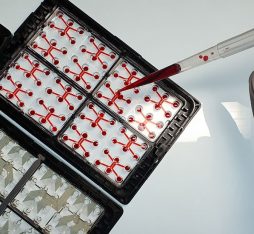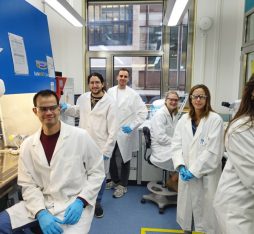● Developed in Cambridge, spiderweb inspired sensors, which are virtually zero-waste, can be printed on demand and remain robust and functional for several hours.
● Other universities are working on projects combining electronics and living cells, among them the University of Chicago, which has developed an innovative patch for the treatment and remote monitoring of skin conditions like psoriasis.
Once the stuff of science fiction, thanks to advances in the emerging field of bioelectronics, sensors that can be spun directly onto human fingers to measure heart rate or the electrical activity of nerves and muscles (electromyography) could soon be a reality. They are just one innovation in a new generation of bioelectronic devices that interface with biological systems. “These include the human body as well as animals and plants etc.,” explains Yan Yan Shery Huang, a professor of bioengineering at the University of Cambridge. In the future, devices of this kind could, for example, be used to monitor electrical signals in plants, paving the way for enhanced cultivation techniques and disease detection, as well as numerous other possibilities in the realm precision agriculture.
Environmentally sustainable sensors
The researcher has developed a system that spins sensors onto skin or the epidermis of plants, using threads as fine as silk. “We sought inspiration from spider webs when we were looking for solutions to reduce the carbon footprint of sensors, many of which, like Covid tests, are only used once before they become waste.” The new sensors use hardly any materials — no more than the equivalent of a few strands of hair.
It’s a fairly robust system which, if left untouched, can operate for up to six hours and even for longer on plants.
Shery Huang’s approach could revolutionize the manufacturing of sensors since devices produced using the new technique can simply be created on demand. The system devised by the professor and her team winds an electronic silk thread around a patient’s finger following a specific pattern. Once it has been positioned, the thread can detect in the body, which can then be retransmitted via a peripheral circuit for analysis and display.
New sensors to monitor bladder fullness
The Cambridge researchers are not alone in exploring possible applications of bioelectronics in healthcare. Researchers at Northwestern University have developed a soft and flexible, battery-free implant that attaches to the bladder wall. The sensor stretches when the bladder dilates, measuring the level of strain. It then communicates information on the level of fullness via Bluetooth to the patient’s smartphone. The new innovation could do much to improve the lives of people suffering from paralysis, spina bifida (birth defects of the spinal cord), bladder cancer and other bladder conditions.
A breakthrough in living bioelectronics
Researchers working on an even more complex technological initiative, the active biointegrated living electronics platform [ABLE] at the University of Chicago have developed an electronic patch that captures physiological signals and administers targeted treatment. The wafer-thin device is made up flexible sensor circuits combined with an ultra-soft hydrogel capable of mimicking tissue, which is made from tapioca starch and gelatine. The gel also contains living cells, staphylococcus epidermidis bacteria that are normally present on human skin, which secrete compounds that reduce inflammation. The inclusion of living microbes in a device of this kind has ushered in the possibility of new interaction with biological systems and the creation of innovative therapeutic functions, notably in the field of skin diseases. In recent tests on mice, the team successfully demonstrated that the battery-free device could be used for the wireless real-time monitoring of psoriasis.
Picture: person wearing bioelectronic fibre arrays for dual-ECG signal acquisition / credit: Wenyu Wang and Yuan Shui
Sources :
Wang, W., Pan, Y., Shui, Y. et al. Imperceptible augmentation of living systems with organic bioelectronic fibres. Nat Electron (2024). https://doi.org/10.1038/s41928-024-01174-4
Biopotentials are electrical signals that occur within living organisms, which are generated by a difference in charge between the interior and exterior of cells that gives rise to an electrical potential or voltage.
 Yan Yan Shery Huang
Yan Yan Shery Huang











